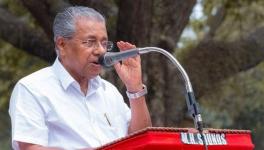Uttar Pradesh Worst Performer in NITI Aayog Health Index, Kerala top for 4th Year
Lucknow: With less than three months left for the Assembly elections, the Yogi Adityanath government has received some less than flattering news with Uttar Pradesh (UP) once again figuring at the bottom of 19 large states and Left-rule Kerala emerging as the state with the best overall health performance for the fourth consecutive year on the fourth NITI Aayog Health Index for 2019-20.
The NITI Aayog, released on Monday, comes at a time when the Bharatiya Janata Party has been trying to portray a “transformed’ UP under Adityanath government. Marking his government’s fourth year in office in March, Adityanath had said that the status of UP as a ‘Bimaru’ had been lifted to ‘Samarth’ (capable).
In terms of institutional deliveries—life-saving equipment and hygiene—UP was the worst both in 2014-15 (43.6%) and 2019-20 (60.8%). UP, which was followed by Bihar and Madhya Pradesh as the second- and third-worst performers, drew some consolation by registering the highest incremental performance from the base year (2018-19) to the reference year (2019-20) after performing better in 33 of 43 indicators/sub-indicators, according to the report.
Mizoram was the best overall performer among the smaller states and Nagaland the worst. Among the large states, Kerala was followed by Tamil Nadu and Telangana, according to the report, which was developed by incorporating 24 indicators in health outcomes, governance and information and key inputs and processes.’ Among Union Territories, Delhi and Jammu and Kashmir were the worst overall performers but improved their rankings significantly in incremental performance.
The report was prepared in collaboration with the ministry of health and family welfare with technical assistance from the World Bank. The first round of the Health Index, released in February 2018, measured the annual and incremental performances of states and UTs for 2014-15 (base year) to 2015-16 (reference year). The second round of the Health Index took into account 2015-16 (base year) to 2017-18 (reference year).
“Previously (before National Rural Health Mission), UP and Bihar were known as BIMARU states, but the names were derogatory. NRHM called Uttar Pradesh, Bihar as “EAG- Empowered Action Group” states and promised them more national funding as was needed in states lagging behind,” Nafis Faizi, assistant professor of community medicine at JN Medical College, Aligarh Muslim University, told Newsclick. He added that the government “needs to have long-term projects to improve health infrastructure.”
Faizi said “as per the National Health Mission (NHM), there should be a point of healthcare at every 3 km, however, in many places in eastern UP and especially in Bundelkhand region, there is lack the access to such facilities. Private practitioners are also not found in these regions due to market failures”.
According to medical experts, the state government needs to focus on strengthening the Primary Health Centres (PHC) and Community Health Centres rather than stressing improving the services at medical colleges and their associated hospitals.
“The state government never focussed on strengthening the primary health centres. Poor services at PHCs in Uttar Pradesh are a major concern. The health infrastructure in rural areas is pathetic and medical services almost absent,” Dr Sharad Gupta, a senior paediatrician and former president of the Indian Medical Association, Agra, told Newsclick. “The government should take note of the health index and take necessary measures to improve the health infrastructure in the state.”
Sushil Prakash, a public health expert in UP, commented in a similar vein: “No matter how hard the government tries to portray a good image of the state in advertisements, UP is still ‘Bimaru’ in terms of health services.”
According to him, the state government is “trying to manage the health services only by focussing on medical colleges and district hospitals. No measures have been taken to strengthen Primary Health Centres. The situation won’t improve until the government concentrates on basic health facilities in rural areas”.
Stating that people engaged in the health sector are not paid properly for their services, another health expert said that the pay scale of Asha-Anganwadi workers is poor, and the shortage of doctors in rural areas is one of the biggest challenges. The working conditions at the PHCs are also not conducive. While doctors are not provided accommodation and transport, officials have a fleet of cars, the expert told Newsclick.
Get the latest reports & analysis with people's perspective on Protests, movements & deep analytical videos, discussions of the current affairs in your Telegram app. Subscribe to NewsClick's Telegram channel & get Real-Time updates on stories, as they get published on our website.
























